We have realised why this is the playground of the rich yachting fraternity. Arriving by water is the only way to get around! The coast road is a permanent and endless queue of vehicles and driving becomes an extremely unpleasant experience. Motor bikes, scooters and cyclists weave their way between the traffic as the fastest way to travel – possibly to the world beyond! Pedestrian crossings and traffic lights are every few metres, there is nowhere for an over-height vehicle to park and French road signing leaves a lot to be desired. Within the towns in the south of France there is often, but not always, a policy of giving way to traffic from the right. This can be rather disconcerting and yet another thing to be aware of. Fortunately, when travelling east along the coastal route, unless Poseidon is arriving in town you are most unlikely to need to worry about this!
Beyond Cannes we made for Juan-les-Pins, another chic resort of shady boulevards and smart flats, their balconies filled with flowering geraniums. We didn't even try to stop. There was nowhere for Modestine despite passing car parks only half full. In any case, we wanted to visit the little inland town of Vallauris, famed for its artistic pottery and for the frescoes in its chapel painted by Picasso. A steep climb brought us to the centre of this pleasant little town with its narrow streets, brightly rendered façades, faded wooden shutters and washing hanging from many upstairs windows. It contrasts very agreeably with the modern seaside resorts below. There seems to be a large immigrant and Creole population here with specialist butchers and food shops. From one of these we bought some rather interesting and very nice vegetable tarts for lunch filled with bright red peppers in a spicy sauce.
On arriving we were fortunate to find one of the rare parking spaces where Modestine could fit. We were less fortunate to find the chapel and Picasso museum on the point of closing for a two hour lunch break. We contented ourselves with photographing the exterior and a sculpture by him we found elsewhere in the town.
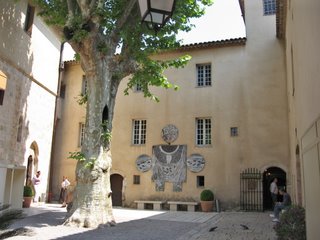 Ceramics museum and Picasso chapel in the castle, Vallauris
Ceramics museum and Picasso chapel in the castle, Vallauris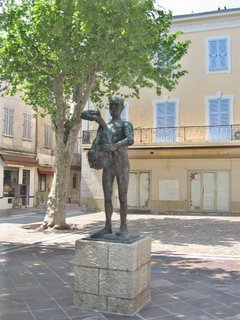 Sculpture of goatherd by Picasso, Vallauris
Sculpture of goatherd by Picasso, Vallauris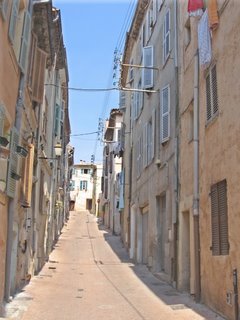 Backstreet in Vallauris
Backstreet in Vallauris Square in Vallauris
Square in VallaurisThere were many galleries around the town where works by various potters were exhibited. We visited a couple of these, including one held in a deconsecrated chapel where the brightly coloured plaques and large oval bowls had something of the style of Picasso about them. There were also many shops selling ceramics and pottery that had been mass produced in all the bright colours of Provence. The window displays were very bright and attractive.
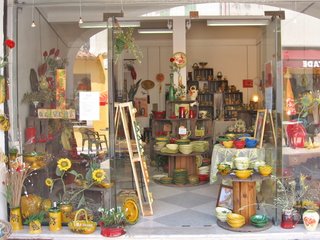 Ceramics shop, Vallauris
Ceramics shop, VallaurisOur route took us back down to the seafront and on towards Antibes. First though we explored the route around the Cap d'Antibes with its pretty coves, sparkling sea and views across to Nice further around the coast. Eden-Roc Hotel is apparently where the famous and the fabulously wealthy lounge about by the pool high on the hill overlooking the sea. From there this area must look like Paradise.
By now temperatures were well up into the 30s and we were hot and very sticky. Parking had proved quite impossible and we had rounded the headland before we discovered a tiny side road with a Modestine-sized space outside one of the minor hotels. (Cheapest room prices here were 550 euros a night for a double room but it did include a continental breakfast. Bargain!)
We found a way down to the beach, la Plage de la Garoupe. Beautiful from a distance the sand proved to be covered in seaweed, strewn with a flotsam of plastic bottles and smelling slightly unpleasant. The little path behind was smothered in dog's mess and there were far too many human bodies on beach towels burning in the hot sun. We did paddle amongst the seaweed and the water was quite warm, but it didn't look too inviting at close range for a swim. We watched in fascination as someone from one of the beach restaurants worked steadily away raking the seaweed from his stretch of beach back into the sea. Seconds later it had been washed up again. The rake made no progress whatsoever!
 Distance lends enchantment to la Plage de la Garoupe, Cap d'Antibes
Distance lends enchantment to la Plage de la Garoupe, Cap d'Antibes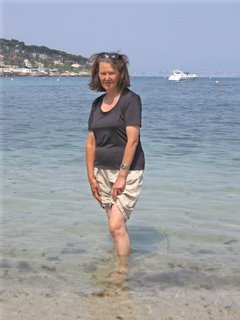 Not so much a Venus as a large Botticelli! la Plage de la Garoupe, Cap d'Antibes
Not so much a Venus as a large Botticelli! la Plage de la Garoupe, Cap d'AntibesEventually we drove round into Antibes itself. This really is a very attractive and interesting resort with a very enjoyable walk around the old walls up to the citadel offering views across the water to Nice where planes were landing on the coastal airport runway every few minutes. There is apparently an excellent Picasso museum here too, given to the town by the artist himself in gratitude for the time he spent working here. At Antibes the beaches were cleaner and the sea really did look inviting. Again there were too many red bodies on the beach but there were also some very slim and beautiful young ones roller blading, jogging or just posing along the espladade where pines and palms offered shade to wimps like us.
 Antibes
Antibes Fortifications at Antibes
Fortifications at Antibes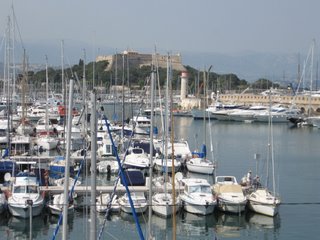 Harbour and Fort Carré, Antibes
Harbour and Fort Carré, AntibesWe spent longer than we realised in Antibes, definitely the nicest of the resorts all the way along this dream coast. By the time we were ready to continue our journey eastwards the roads had become clogged solid again. We suffered it as long as we could but it became just too unpleasant so we simply turned out of the jam into a campsite we were passing and decided to stay here until tomorrow. The sea is hidden from view by the railway line, the clogged-up main road and lots of rather rundown shops and warehouses. The campsite is deserted with only us here but it seems quite reasonable. We have discovered the train stops nearby on its way to Monte Carlo so we may stay a couple of nights, leaving Modestine here while we go off tomorrow to Monaco.
Saturday 6th May 2006, Villeneuve-Loubet-Plage, Nice, Côte d'AzurWe are still on the same campsite having spent the day, as anticipated in Monaco. During the night it rained. After the heat of yesterday it was very pleasant to be lulled to sleep by the sound of raindrops steadily pattering on Modestine's roof. Fortunately for us it was far Rainier on our campsite last night than it was in Monte Carlo today, where the sky was overcast though dry and comfortably warm. A perfect day in fact for sight-seeing on foot in such a hilly place as Monaco.
The train runs along the seafront, through some very beautiful areas of 19th century villas high on the cliffs overlooking the sea, and luxury holiday apartments for the very wealthy. Below there were frequently parks filled with pine trees, palms and flowering shrubs with the Mediterranean as a constant azure backdrop. On the landward side though, particularly around Nice, there are dilapidated blocks of flats, walls covered in graffiti, burned-our cars, rubbish tips and a general air of menacing dilapidation.
We had intended to stop at Nice on our way, to stroll along the highly reputed Promenade des Anglais. However, the town did not appear very enticing from the train and the station was located well back from the seafront, so we decided to visit Monaco first and see how much time we had left on the way back.
The independent state of Monaco, just over a mile in length, is a tiny enclave within France squashed in between the sea and the mountains. It houses an enormous population to judge by the way luxury skyscraper flats have been squashed into the city, building up the sheer cliffs that surround the state. There are free lifts to whisk the public up the cliff face from one part of the city to another. We only realised this after we had struggled our way up the steep route with its multiple bends from the railway station to the exotic gardens. Getting down was considerably faster but we still seem to have walked up and down an enormous number of steep cliff roads today. From such dizzy heights, to recoin a phrase, Monaco was all we surveyed!
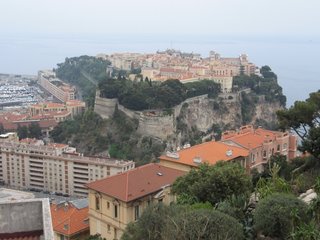 The old walled town of Monaco
The old walled town of Monaco One of the elegant older streets in Monte Carlo, Monaco
One of the elegant older streets in Monte Carlo, MonacoThe city is very chic and smart, as might be expected, but with a surprising amount of dogs mess sprinkled over the pavements. The city has become so rich from the profits of the gambling industry that taxes have been abolished here. This attracts tycoons and moguls which in turn brings in further revenue for the principality. There was a stunning display of wealth in the harbour with huge yachts moored tightly together, many from Georgetown in the Cayman Islands.
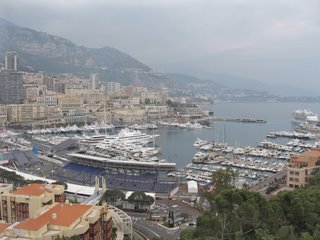 The port of Monaco
The port of MonacoAt 11.55 each day the guard is changed outside the royal palace on the top of yet another hill, defended by the city walls and ramparts. We climbed up there in good time and had an excellent view as the six guards representing 50% of the Monaco army exited from the palace and conducted a minor ceremony, handing over the security of the Prince to the remaining 50%. All this to the great excitement of all the tourists from countries where they no longer have a monarchy yet love the pageantry of those countries where they have been retained.
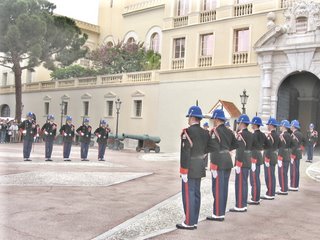 They're changing guard at Grimaldi's Palace, Monaco
They're changing guard at Grimaldi's Palace, MonacoWe did not have time to visit the state apartments, museum or exhibition of Napoleana. Instead we walked through the narrow streets of the old town, now largely given over to tourism, to find the cathedral. This is an expensive and extravagant piece of 19th century architecture in white limestone that makes the Sacré Coeur in Paris look basic and minimalist! Here the monarchs of Monaco are buried and we joined the queue to file past their tombs. The last two are of Princess Grace and her husband Prince Rainier III who died in 2005. We recall that Grace Kelly was an American film star who won the heart of the Prince of Monaco to the great joy of the American public who now had their own "Royal Family" in Europe. Tragically Princess Grace was killed in a car accident in the 1980s.
 The Cathedral, Monaco
The Cathedral, MonacoCurious as Monaco and its royalty may be, the other facets of this principality hold every bit as much attraction to the visitor. The Monaco Grand Prix is due to take place through the mountainous twisting streets of the town on 17th May and already stands had been constructed to offer people birds-eye views as the cars race through the centre.
 Monte Carlo race track, Monaco
Monte Carlo race track, MonacoThe other aspect everyone associates with Monte Carlo is gambling and it is on the revenue this brings that much of the principality's wealth is based. The casino is an elaborate neo-baroque building designed by the same architect as the Paris Opera House. Inside, memories of being searched in the Biarritz casino in mind, we handed in our rucksack immediately. We were also asked to hand in our camera in case we thought of taking any sneaky photos to put onto our blogsite. So sorry about the lack of pictures of the inside!
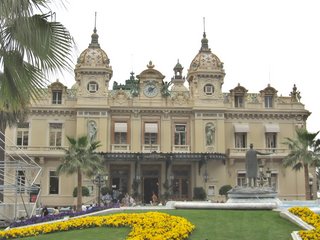 Monte Carlo Casino, Monaco
Monte Carlo Casino, MonacoOur newly discovered gambling skills that had brought us such phenomenal success with the Issoir pissoir machine encouraged us to believe we could be the next to break the bank at Monte Carlo. Our hopes were dashed though when we were told it would cost us 20 euros each just to go into the private rooms with the tables before we even started playing! We browsed the displayed rules for playing chemin-de-fer, black jack, roulette, baccarat and crap and decided we were not really cut out for this lifestyle.
Outside we wondered at the highly ornate façade of the Hotel de Paris where huge cars with registration plates reading "Play BOY" or "JOE5" were drawing up at the entrance, the occupants helped out by uniformed attendants and the vehicles driven away to be garaged. An elegant lady and her dog stepped out from one such vehicle and disappeared through the main door of the hotel. No doubt after rubbing the fetlock of the equestrian statue of Louis XIV in the lobby, in the time honoured fashion of gamblers, she and her dog will cross the road to play blackjack and crap in the casino!!
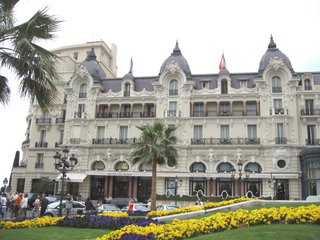 Hotel de Paris, Monte Carlo, Monaco
Hotel de Paris, Monte Carlo, MonacoBy this time we were exhausted and sank into chairs on the terrace of the Café de Casino on the other side of the bright flowerbeds in front of the Hotel de Paris, hoping for some refreshment. When the waiter arrived and we realised it would cost us 10 euros just for a couple of thimbles of too strong coffee we discovered the energy to leave in record time!
Gradually we made our way back to the station, searching for an internet café. Prices here were similarly expensive so we gave up and after an equally good but much cheaper coffee at the railway station we caught the return train home. Our intention to get off at Nice was scuppered as we were both almost asleep when the train passed through the station and we would have been far too weary to walk the mile down to the Promenade des Anglais anyway. As Ian said later, "Funny that things supposed to be nice are not always as good as you would expect. Nice biscuits are always the ones left on the plate when all the others are eaten, and from all the towns we have visited on the Cote d'Azur, Nice is the one we have left on the plate!" This may seem unfair to Nice but it did not look at all attractive from the train.
We dragged ourselves down to the beach at Villeneuve-Loubet-Plage when we got off the train. It is a pebbly beach but the sea is a beautiful pale blue-green. Too rough for swimming though. Back at the campsite we have spent the evening planning our route into Italy. We will probably move on from France tomorrow.
Sunday 7th May 2006, Oasi Park, Diano Marina, Italy
Today has been interesting, Modestine has been locked up as an undesirable character and we have left France with a Police record!
It all started so very pleasantly. We left our campsite in France and used the motorway to pass behind Nice and Monaco high in the mountains on a route that passed alternately through long tunnels in the mountains, and along high viaducts across deep gorges and ravines. The engineering work calls for the greatest respect.
We could have continued along the autoroute to reach Genoa. Once we had gained the height it would have been fairly level. However, we wanted to visit Menton, the last town in Southern France, just a kilometre from the Italian border. So we exited the motorway and climbed steeply down from the mountains into the town and finally along the seafront lined with palm trees and a flowering promenade.
This town was where the French poet, playwright and painter Jean Cocteau lived and worked in the 1950s. As we had both studied his works years ago for A level French we were interested to visit the Cocteau museum here. The fact that it turned out to be a beautiful, yellow stuccoed town with steep, shady, narrow streets and several beautiful churches was an added bonus. Here we found Italian being spoken as regularly as French. There was a delightful pleasant Sunday feel to the town which offered us a wonderful foretaste of Italy.
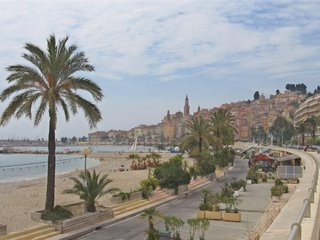 Seafront at Menton
Seafront at Menton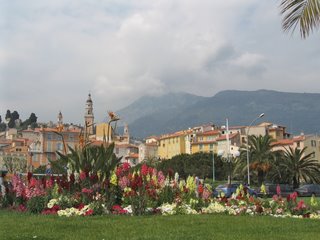 The old town at Menton
The old town at MentonDriving along the seafront we found the usual problem of being unable to enter into any of the car parks because of height restrictions. Where there was on-street parking signs warned of the dire consequences of parking camping cars on the streets. Eventually, on the very limits of the town, within sight of the Italian frontier post a few metres further on we found a place by the roadside along with several other parked cars and vans.
We walked back along the sea front to explore this delightful little town crowded with weekend visitors enjoying seafood platters at the many little restaurants and bars. We were delighted to discover that the Cocteau museum in the old bastion was free today. Apparently many museums open without charge on the first Sunday of the month.
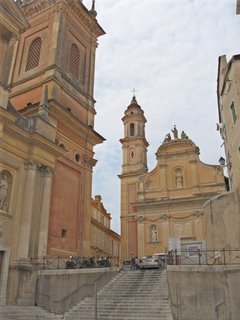 Backstreets of Menton
Backstreets of Menton Bastion, now housing the Cocteau museum, Menton
Bastion, now housing the Cocteau museum, MentonThe exhibition was superb and brought back a sense of nostalgia despite having studied his literary works, particularly Oedipus Rex, rather than his artistic creations. His drawings are deceptively simple but very effective. His fauns have an almost dream-like quality. He was a friend and contemporary of Picasso. The portrait sketch by Picasso made during Cocteau's youth shows just how capable Picasso could be as a realist painter. Much of Cocteau's work was quite avant-garde, its symbolism difficult to understand, but it gave pleasure and commanded great respect, especially as he considered himself as a writer who painted rather than primarily an artist.
 Stone mosaic by Cocteau, Menton
Stone mosaic by Cocteau, Menton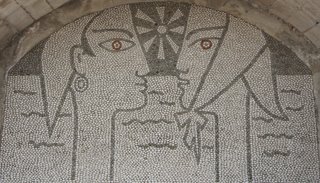 Stone mosaic by Cocteau, Menton
Stone mosaic by Cocteau, MentonReturning happily to Modestine a couple of hours later we were horrified to discover her clamped in a yellow Denver boot! A note in French informed us we needed to report to the Police station and pay a fine of 35 euros immediately as we were an illegally parked camping car! Nearby stood a distressed German couple with a very small camper van who had parked for 10 minutes to go in search of a toilet – of which there were none on this side of the town! They spoke no French and did not understand what they had done wrong! Fortunately Ian's German came in useful. Seeing us obviously angry and concerned another German approached saying he's lived in Menton for 25 years and had become progressively disenchanted with the attitude of the police in the town. He offered to go with the German couple and us to the police station and try to sort things out.
After a two kilometre walk back into town we found the police station. The German resident then wound the police up nicely in knots, pointing out how ridiculous it was to suggest either of us was taking up more space than neighbouring vehicles. The police were obviously aware they had made an error of judgement but there was no way they would back down.
Legally in Britain Modestine has always counted as a car. She is basically a Citroen Berlingo and is registered as a car rather than a camping car. She fits in most car parks, takes up no more room than a car, pays as a car on motorways and ferries and is a fraction of the size of a camping car. We showed the police her registration document stating that she is a car. They said we slept in her. We said we not sleeping, just visiting the Cocteau museum and looking for a toilet as we had no such facilities in our car. We pointed out that the vehicle parked in front of us was French and twice the size of Modestine but had not been wheel clamped. They said it was because it was a van and not a camping car! We said maybe there were people sleeping in there. They said it didn't matter, it wasn't a camping car! We invited them to look in Modestine, piled high with folding bikes and explain how they thought there was room for anyone to sleep in her. They said they didn't make the rules, only applied them. If we refused to pay they would not remove the Denver Boot. They did concede the logbook said she was a car and yes she was a Citroen Berlingo with only a 1.9cc engine but rules is rules. We could complain to the Mairie if we liked - not easy on a Sunday afternoon! In the end we paid them 15 euros to remove the boot and refused to pay the rest of the fine. We and our fellow German sufferers feel it is victimisation of foreign visitors. Big French camping cars could be a problem certainly, but we both had very tiny vehicles, based on French car chassis, far smaller than camping cars manufactured in France. We bought Modestine because she is small and counts as a car but the French have never been good at lateral thinking. We also asked where in the town we could have parked and were told nowhere, camping cars are not wanted. We said we were not a camping car……!
Incidentally, despite the beauties of the town of Menton (which means chin) the streets were smothered in canine deposits. This is also against police regulations but is ignored. We reckoned the police should concentrate on using a Denver boot to clamp the rear ends of offending dogs rather than persecute innocuous tourists!
Having duly paid our 15 euros each – they can sing for the rest – our new German friends took us off for Italian ice creams on the seafront. Why hurry back, we'd paid the fine. We might as well enjoy ourselves! They were very pleasant people and they have suggested we call on them if we are passing through Bavaria on our way to Hungary when we move on from Italy.
 Modestine gets a criminal record! Menton
Modestine gets a criminal record! Menton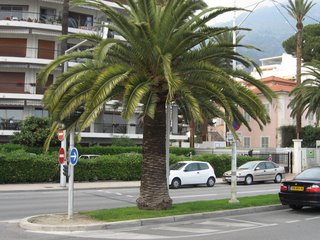 This is the No Camping Cars sign we missed behind the palm tree! Menton
This is the No Camping Cars sign we missed behind the palm tree! MentonFreed at last we waved farewell to our new friends and crossed the border into Italy. The route winds slowly round the coast towards Genoa. How long we will need to follow it we don't yet know. It passed through countless little Italian seaside resorts nestling beneath the tall mountains and as far as we can work out we are not welcome here either with restrictions on all the car parks. We turned off at a campsite which looked rundown and rather expensive at 24 euros. We decided to press on for a while and have now discovered a special reserve for camping cars. We are hoping it is not a fluke because it is wonderful! There are several dozen vehicles here but it is quiet, shady and pleasant, 400 metres from the sea with immaculate facilities. There are showers, toilets – with seats and loo paper! Even the wash basins have plugs! With electricity it is costing us 10 euros a night! Maybe they are provided at such a reasonable cost because it ensures they are not on the streets over night.
Win some, lose some. We didn't pay for a car park in Menton, nor did we pay for the museum. We met some delightful German people and had free ice creams. This camping car reserve is 14 euros cheaper than the campsite. All in all we are up on the deal even after paying 15 euros release fee to the French police.
